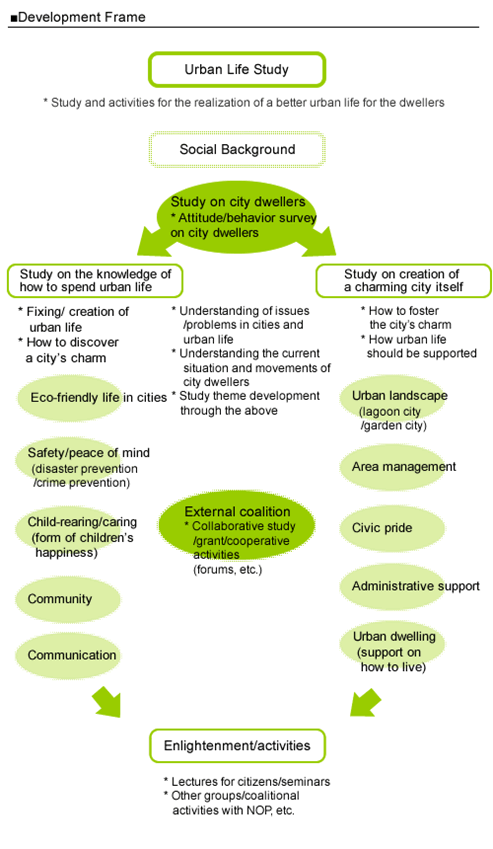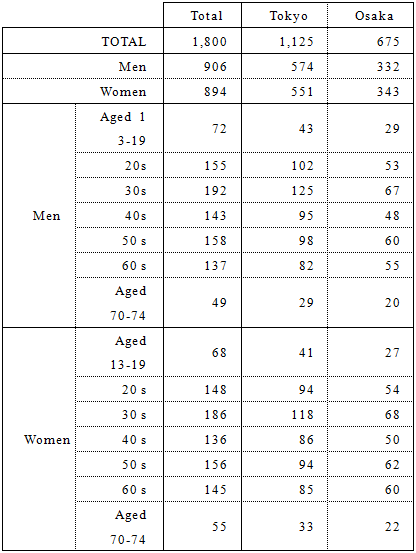Attitude Survey of City Dwellers 2010
Attitude Survey of City Dwellers 2010
Purpose of this Study
1. Study development of the Research Institute for High Life and positioning of this survey
Since its foundation, the Research Institute for High Life has been conducting studies on urban life for the purpose of “realization of a better life for city dwellers.”
“Urban life” is defined as a contemporary lifestyle in a highly industrialized society. With the economic growth and upgrading in our country following the war, urbanization developed coincidentally in two aspects, the maintenance of urban functions and the realization of an enriched life, changing people’s lifestyles ever since.
The current development of our urban life study is implemented based on the following two themes. (Figure 1-1)
Study on the creation of a charming city itself
This includes studies on the discovery and fostering of a city’s charm, and how urban life should be supported, etc., aiming to extend the breadth of values and charms of the city itself.
Study on the knowledge of how to spend urban life
This includes studies on the development of new ways of living that correspond to fixing problems and changes in society, etc., aiming to discover and create knowledge regarding living activities that enrich urban life.
It is important for a study on urban life to be based on studies concerning city dwellers themselves. Understanding the needs and current situation of urban life and dwellers, as well as future movements, will enable the creation of a base for future studies that are more assuring. “Attitude Survey on City Dwellers 2010” is truly a practice as a basic study for this purpose.
This survey aims to attain the basic viewpoints of the following two themes that will be the development of the urban life study: “Study on the creation of a charming city itself” and “Study on the knowledge of how to spend urban life.”
Figure 1-1: Frame of Urban Life Study Development

2. Standpoints of this Survey and Survey Overview
(1) Standpoints on survey planning
This survey is meant to understand what sorts of ideas city dwellers have, or how they would like to live their lives in the future, in ever-changing economies/societies, communities and family environments. Furthermore, we also set out to reveal what sort of awareness they have of challenges, in order to “realize a better urban life.”
Also, when planning the survey, we paid sufficient attention to the following effects considered to have a tremendous impact on the values and actions of city dwellers.
Progress of industrial society and urban life
An industrial society that aims for efficiency, faster speeds and higher density tends to put a variety of stress on city dwellers, such as widening disparity and a distorted work-life balance. On the other hand, it seems that city dwellers have also started to change their view of life, such as by showing respect for a slower life or regional context, in an attempt to counteract this stress.
Economic fluctuations and urban life
Due to the financial disaster of September 2008, the economies in advanced nations suffered dramatic setbacks, and Japan, in particular, was forced to face an extremely severe deflationary spiral. It is speculated that while the industrial world was busy dealing with the strong yen, the impact on the household economies of city dwellers was quite substantial. This survey was implemented in the fall of 2010. It is assumed that this was the time when the effects of the deflationary economy would emerge clearly in the actions and conscious minds of city dwellers.
Penetration of ICT and urban life
The advancement in information communication technology has been incorporated into everyday life, accelerating the metabolism of existing businesses, and even changing the landscape of the city.
Aging and urban life
The speed of aging of our country is much faster than any other advanced nations. Although we can boast of the longevity of Japan’s society, the negative aspects are more obvious, such as our fragile national finances and increased burden imposed on the young. We are very concerned about the arrival of a society in which longevity is becoming acknowledged as a risk. Another concern is leaning towards restricting consumer spending in order to protect life.
Community and urban life
As if skimming the shadows of society, self-motivated activities have started to emerge in citizens, such as life support for the elderly, support for child rearing and support for the disabled. It appears that conventional community activities focusing on regional security and safety have expanded to those community activities that complement peace of mind or enrichment of urban life. There are indications that the role of “community” will be raised higher and higher.
Sustainable society and urban life
A sustainable society is a society that “acknowledges limitations” and can look back on the economy, society, as well as the functions of family life. With the elevating awareness of the environment, resources, energy and recycling, etc., the aspiration of achieving a sustainable society has become a common language around the world.
(2) Compilation of the survey contents
Understanding of the consciousness and actual conditions of city dwellers were compiled over a wide range of areas as shown in the following.
[1] Consciousness and actions in overall living
[2] Consciousness and actions in different aspects of life
(clothing, food, housing, consumption behavior, health/beauty, work/home, etc.)
[3] Consciousness and actual conditions of community
[4] Consciousness and actions for old age
[5] Social consciousness and actual conditions
[6] Income/assets
[7] Sense of values
(3) Points for consideration when planning a survey
Sample structure that sufficiently corresponds to an analysis by different sex and age groups
As a matter of course, consciousness by generation groups are expected to be different; therefore, we will make our observations by different sex and age groups, while looking at overall city dwellers. In so doing, we believe that we can highlight more clearly the consciousness and issues by generation groups. Therefore, it is desirable to arrange a survey that can target a broad range of ages from teenagers to the elderly. With this survey, young and old, men and women are allocated in good balance, with 1,800 samples in total for Tokyo and Osaka.
Measuring changes and depth in consciousness
Fundamentally, the actual conditions and consciousness movement of city dwellers are highlighted clearer over time by continuing the survey for a longer period of time.
The survey this time is the 1st primary survey. Therefore, with respect to the important questions, extra attention was paid in order to understand temporal development, along with the qualitative dynamics of interest, actual conditions and inclinations.
Temporal development referred to, for example, questions like “compared to two to three years ago…” or “in a few years…” which complemented the present time. With respect to the qualitative dynamics, three phases, for example, “level of interest,” “level of involvement in the current situation,” and “your preferred image,” were tried for understanding.
In doing so, we tried to discover a vector of actions by city dwellers in the future.
(4) Survey Overview
[1] Respondents; men and women aged 13 to 74 who live within 30km of Tokyo and within 20km of Osaka
[2] No. of samples (number of valid data collection): 1,800
[Breakdown]

[3] Sample extraction method; area sampling method (regional extraction → individual extraction)
[4] Survey method; Placement method (visit to distribute survey sheets) → respondents fill out → visit to collect)
[5] Survey period; from October 1, 2010 (Fri.) to October 18 (Mon.)
[6] Organization of survey research:
Research institution: Research Institute for High Life
Research organizer: Shinji Takatsu, Representative, Research Institute for High Life
In charge of research implementation: Behavioral Science Institute
In charge of research study:
Yoshinori Hiroi, Professor at Chiba University
Yoshio Tatsuzawa, Representative, Market Place Office
Toshiaki Tanno. Behavioral Science Institute
Atsushi Mizushima, Lecturer at Jiyugakuen
Haruki Takatsu, Executive Director, Research Institute for High Life
Hirohito Hagiwara, Bureau Chief, Research Institute for High Life
Akihiko Ueno, Senior Researcher, Research Institute for High Life
“Attitude Survey on City Dwellers 2010” consists of the following two separate volumes.
1. “Analysis version”-Consciousness and actions of city dwellers in the social transition stage
2. “Data version”